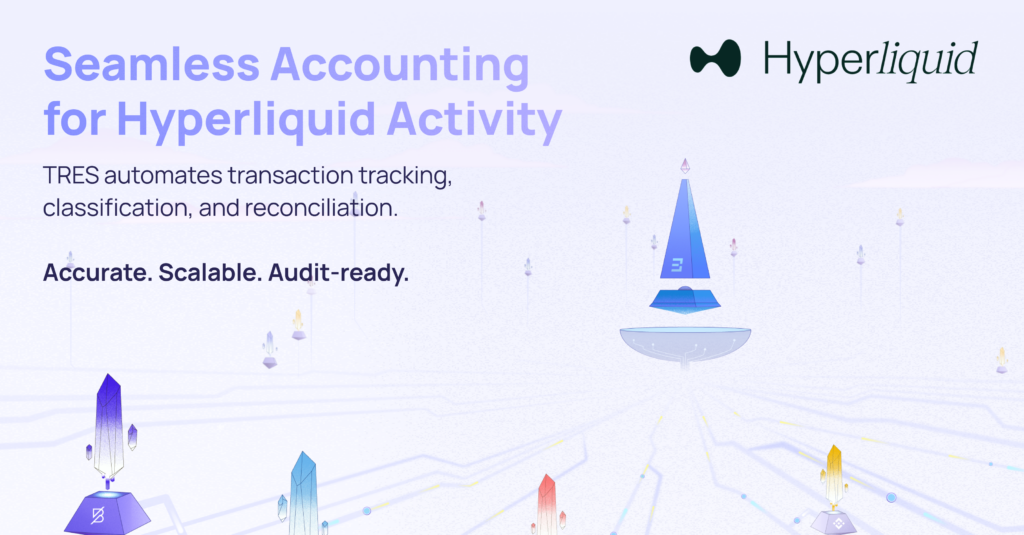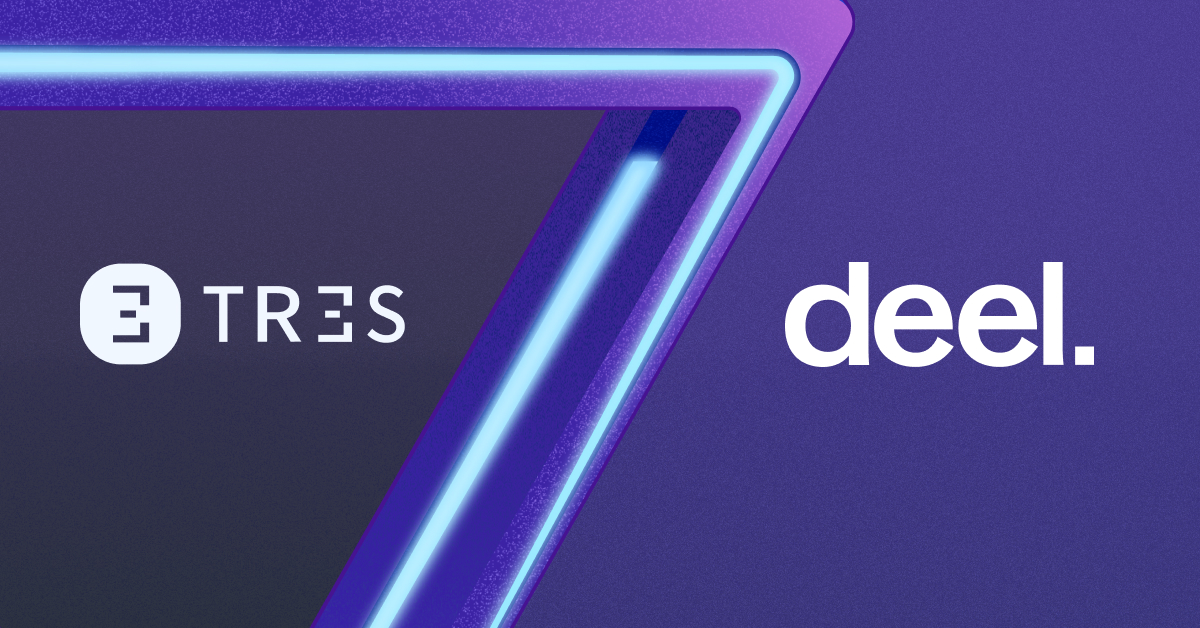
Hyperliquid is redefining performance in DeFi trading. As the dominant perpetual platform – handling over 95% of decentralized volume – it delivers unmatched speed and transparency through a high-performance L1, on-chain order book, and one-block finality.
But its complexity poses a real challenge for finance teams. With layered trading mechanics, staking, vault strategies, and fragmented APIs, Hyperliquid introduces an entirely new dimension to reconciliation.
TRES is the first and only accounting platform to offer native support for Hyperliquid. With this integration, we bring automated reconciliation, precise ledgering, and a unified financial view to the most advanced network in decentralized trading.
What Makes Hyperliquid Different?
Hyperliquid isn’t just another chain – it’s a purpose-built, performance-first environment designed for traders and institutions.
- On-chain order book: Enables real-time trading directly on-chain with full transparency.
HyperBFT consensus: One-block finality for near-instant settlement – ideal for high-frequency strategies.
It’s important to distinguish between:
- Hyperliquid: optimized for trading at scale with high throughput and low latency.
HyperEVM: built for developers to launch dApps, DeFi protocols, and NFTs using smart contracts.
Diverse Activities, Unified Complexity
Hyperliquid supports a wide range of user interactions – all of which alter balances in distinct ways:
- Spot trading: Immediate asset exchange on the order book. For example, a trader can instantly purchase 1 ETH for USDC without needing an intermediary.
Perpetual contracts: Leveraged positions with continuous funding adjustments. Traders can speculate on asset prices using leverage. For instance, they might open a 10x long position on BTC/USDT. - TWAP orders: Large trades split over time to minimize market impact. This method is particularly useful for institutional traders seeking to minimize market impact when executing significant trades over time.
- Staking: Delegating HYPE tokens to validators in order to earn staking rewards. For example, staking 1,000 HYPE tokens may yield an annual percentage yield (APY) of 10 percent, depending on network conditions.
- Vaults : Liquidity pools that support protocols or user-created funds. A user can create a custom vault strategy that aggregates returns from multiple trading activities.
- Transfers: Moving assets on-chain or bridging between Hyperliquid and HyperEVM. For example, users can bridge HYPE tokens from Hyperliquid to HyperEVM to participate in DeFi applications.
The Challenge: Hyperliquid’s Fragmented Data Model
Managing accounting across Hyperliquid means overcoming:
- Disjointed APIs: More than 10 endpoints are required to access spot, perp, staking, and vault data.
- Network-specific logic: Calculating perpetual positions and balances demands a thorough understanding of Hyperliquid’s unique transaction flows and balance structures. Perpetual contracts, for example, include funding rate adjustments that gradually affect a trader’s margin balance.
- Event-level auditing: Each balance-changing event must be audited to maintain an accurate ledger. Spot trades directly modify asset balances, while TWAP orders introduce incremental changes over time. A perpetual trade may cause several small balance shifts based on funding rate dynamics.
- Ledger reconciliation: All events must be consolidated into a unified ledger that ensures the current balance matches the sum of all historical transactions. For example, if a trader begins with 10 ETH, conducts multiple trades, and stakes a portion, the ledger must precisely reflect each action without error.
These complexities make manual or semi-automated systems prone to error – and leave gaps in audit trails.
TRES Solves This…Natively.
1. Normalized data, fully mapped
TRES fetches and consolidates activity across all Hyperliquid products, from spot to vaults, into a unified schema. One API call gives you the full financial picture, ready for audit or reporting.
For example, a trader might execute a spot trade for 5 ETH/USDC, open a 10x long perpetual position on BTC/USDT, and stake 1,000 HYPE tokens. TRES collects this information from different sources and standardizes it, making it easy to apply accounting methodologies. With one API call, customers can access a complete, consolidated view of all their transactions, removing the need for manual data handling.
2. Event-level balance recognition
TRES detects and categorizes every balance-changing event in real time.Perp funding adjustments, staking rewards, vault yields – logging and classifying each with the correct financial treatment.
For example, opening a 10x leveraged long position in a perpetual contract results in an initial margin adjustment, followed by ongoing balance changes from funding rate payments. TRES captures and logs each of these changes in real time, ensuring accurate and complete tracking of all financial movements.
Another example involves staking. If a user stakes 1,000 HYPE tokens and receives 10 HYPE as rewards each week, TRES identifies these rewards as distinct balance-changing events. It categorizes them accurately for both accounting and reporting purposes, ensuring that income recognition is handled correctly and consistently across time.
3. Real-time position & balance statements
TRES builds live financial statements from transaction data. Balances, positions, rewards, and P&L are compiled into clear, reportable outputs for both institutions and individuals.
For example, a trader’s statement might show:
- Balances: 50 ETH, 10,000 USDC, and 1,200 HYPE (1,000 staked, 200 liquid).
- Positions: A 10x long BTC/USDC perpetual position with an unrealized P&L of 100USC.
- Staking Rewards: 50 HYPE earned over the past month.
These statements are vital for both individual traders and institutional players to assess their portfolio’s performance, reconcile discrepancies, and prepare financial reports.
4. Continuous reconciliation, no exceptions
TRES continuously reconciles all financial activity against live balances.
Any mismatch – from a missed fee to a rounding error – is flagged for resolution.
Example: A trader starts with 100 ETH. After staking, trading, and withdrawals, the ending balance must show 85 ETH. TRES ensures the ledger matches to the last decimal.
Generic API Data Isn’t Enough
Raw data from Hyperliquid or third-party providers like Allium lacks financial context and isn’t built for reconciliation.
TRES transforms that raw data into structured, reconciled, user-specific financial intelligence. It’s not just data – it’s clarity.
| TRES | Allium | Hyperliquid API | |
| Schema | Unified GraphQL API for all transaction types and balances. | Unified SQL Schema. | Fragmented Schema per API type |
| Reconciliation | Built-in reconciliation, audited by EY. | Txs Data only, not reconciled. | Data only, not reconciled. |
| Accounting | Classification, Cost Basis, Syncing to ERP. | ||
| Portfolio Management | Cross-wallet & networks portfolio management. | Single Wallet. |
With TRES’ native Hyperliquid integration, crypto finance teams can finally close the gap between real-time trading and real-time reporting – with confidence, speed, and full context.
Book a demo with our team today.
Interested in TRES?





